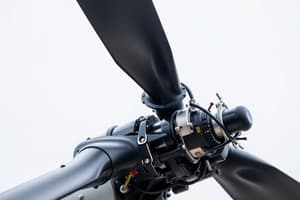Podcast
Questions and Answers
What does the auxiliary rotor on a helicopter help the pilot achieve?
What does the auxiliary rotor on a helicopter help the pilot achieve?
- Maintain airspeed and trimmed flight.
- Control altitude and pitch oscillation.
- Manage torque and directional control. (correct)
- Balance weight and center of gravity.
What primarily controls the vertical flight of a helicopter?
What primarily controls the vertical flight of a helicopter?
- Collective pitch changes. (correct)
- Alterations in rotor RPM.
- Adjustments in fuselage angle.
- Cyclic pitch changes.
What effect does a reduction in anti-torque thrust have on the helicopter?
What effect does a reduction in anti-torque thrust have on the helicopter?
- It causes the tail to pivot against the direction of torque. (correct)
- It results in improved efficiency of the anti-torque system.
- It causes the tail to pivot in the direction of torque.
- It stabilizes the helicopter's hover position.
Where is the ideal location for a cargo release in rotorcraft external-loading?
Where is the ideal location for a cargo release in rotorcraft external-loading?
How does a helicopter change direction in forward flight?
How does a helicopter change direction in forward flight?
What is the purpose of checking main rotor blade tracking?
What is the purpose of checking main rotor blade tracking?
In a hovering helicopter, how is directional control maintained?
In a hovering helicopter, how is directional control maintained?
What happens to the angle of attack of the advancing blade in forward flight?
What happens to the angle of attack of the advancing blade in forward flight?
What does it mean when main rotor blades do not cone by the same amount during rotation?
What does it mean when main rotor blades do not cone by the same amount during rotation?
What is one function of the freewheeling unit in a helicopter drive system?
What is one function of the freewheeling unit in a helicopter drive system?
How does torque effect operate in helicopters?
How does torque effect operate in helicopters?
The movement about the longitudinal axis (roll) in a helicopter is primarily controlled by which pitch control?
The movement about the longitudinal axis (roll) in a helicopter is primarily controlled by which pitch control?
What primarily affects movement about the lateral axis (pitch) in a helicopter?
What primarily affects movement about the lateral axis (pitch) in a helicopter?
Which axis does wing dihedral predominantly contribute to in an airplane's stability?
Which axis does wing dihedral predominantly contribute to in an airplane's stability?
What is a resource other than the manufacturer maintenance manual that can determine primary flight control surface deflection for an imported aircraft?
What is a resource other than the manufacturer maintenance manual that can determine primary flight control surface deflection for an imported aircraft?
What is the main role of the free-wheeling unit in a helicopter's operation?
What is the main role of the free-wheeling unit in a helicopter's operation?
Flashcards are hidden until you start studying
Study Notes
Rotorcraft Control and Functionality
- The auxiliary (tail) rotor compensates for torque and provides directional control in helicopters.
- Vertical flight is controlled by collective pitch changes, allowing for altitude adjustments.
- A reduction in anti-torque thrust causes the tail to pivot opposite to torque rotation around the main rotor axis.
- For external loading, the ideal cargo release location should pass through the center of gravity for stability.
Flight Dynamics and Maneuvering
- In forward flight, helicopters change direction by tilting the main rotor disk in the desired direction.
- Checking main rotor blade tracking assesses the relative position and flight path of the blades during rotation.
- In a hover, directional control in helicopters relies on varying the pitch of the tail rotor blades.
Blade Performance and Rotor Dynamics
- In forward horizontal flight, the angle of attack of the advancing blade is greater than that of the retreating blade.
- Main rotor blades that do not cone equally during rotation are identified as being out of balance.
- The freewheeling unit between the engine and helicopter transmission allows for disengagement of the rotor in case of engine failure.
Torque and Control Surfaces
- The direction of torque in helicopters is opposite to rotor blade rotation; as horsepower decreases, torque increases.
- The freewheeling unit also helps in starting the engine without load from the transmission, enabling autorotation practice.
- Roll movement about the longitudinal axis in helicopters is controlled by cyclic pitch control, while pitch movement about the lateral axis is similarly affected.
Aircraft Rigging and Documentation
- Wing dihedral significantly contributes to stability around the lateral axis in conventional aircraft.
- The Aircraft Type Certificate Data Sheet can help determine control surface deflections for imported aircraft reassembled after shipment, alongside the manufacturer maintenance manual.
Studying That Suits You
Use AI to generate personalized quizzes and flashcards to suit your learning preferences.




